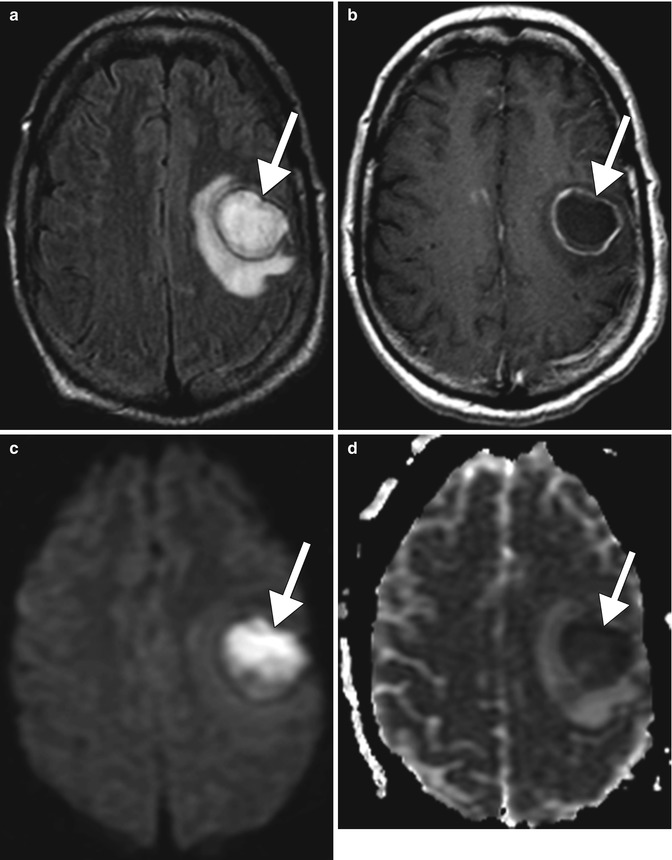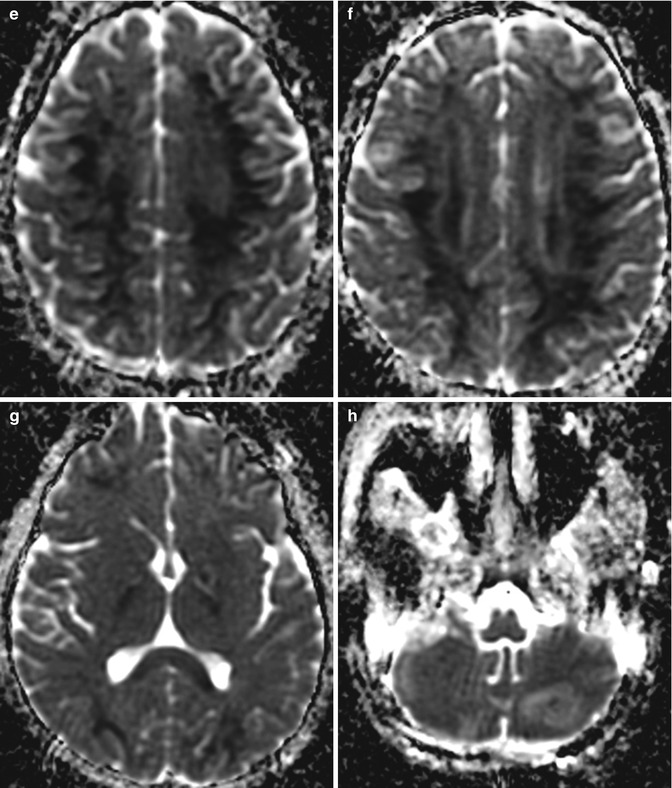
Fig. 7.1
Heroin-induced leukoencephalopathy (chasing the dragon). Axial FLAIR images (a–d) and ADC maps (e–h) show diffuse confluent cerebral white matter signal abnormality with restricted diffusion that spares the subcortical white matter, producing a “dragon’s claw” appearance (arrows)
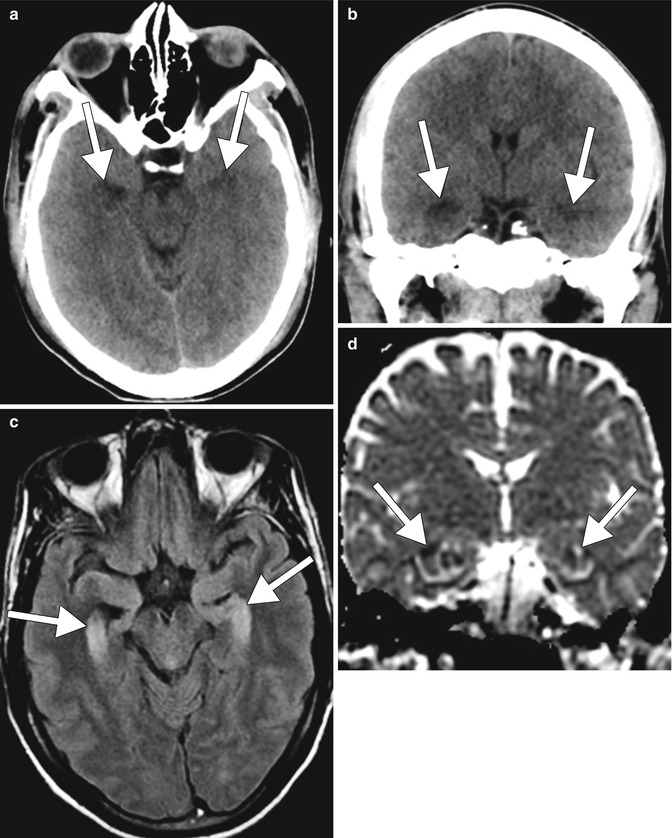
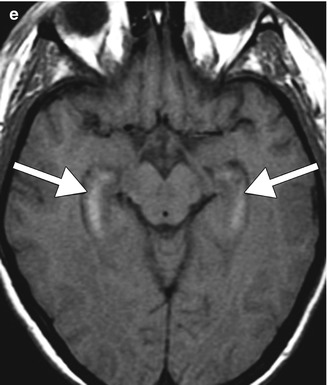
Fig. 7.2
Heroin induced hippocampal infarct. Axial (a) and coronal (b) CT images show hypoattenuation within the bilateral hippocampi (arrows). The corresponding axial FLAIR (c) and coronal ADC map (d) show signal abnormality with restricted diffusion in the bilateral hippocampi (arrows). Axial T1-weighted MRI (e) obtained at follow-up shows bilateral hippocampal cortical laminar necrosis (arrows)
Other opioids, such as methadone, can produce toxic leukoencephalopathy with imaging findings that are similar, but not identical to those of heroin inhalation. In addition, other opioids, such as oxycodone, which have a predilection of kappa receptors, can cause acute neurotoxicity with predominant cerebellar and globi pallidi lesions (Fig. 7.3).
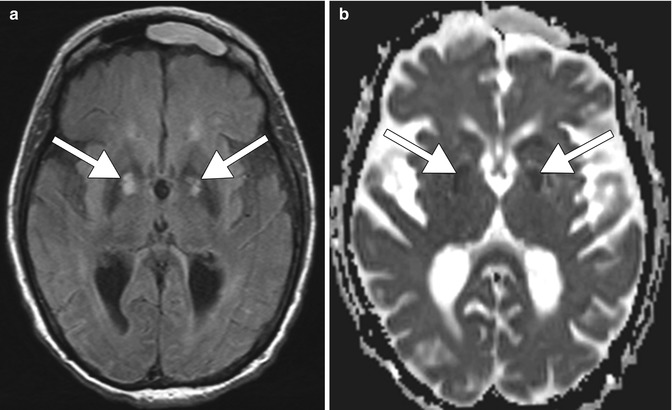

Fig. 7.3
Acute oxycodone intoxication. Axial FLAIR (a) and ADC map (b) show abnormal signal and restricted diffusion within the bilateral globi pallidi (arrows)
Delayed posthypoxic leukoencephalopathy can be caused by opioid overdoses that result in respiratory failure and prolonged cerebral hypo-oxygenation. This condition has a classic biphasic presentation, in which there is full recovery from an obtunded or comatose state followed days or weeks later by an acute onset of neuropsychiatric findings including disorientation, amnesia, hyperreflexia, frontal release signs, parkinsonism, akinetic mutism, or psychosis. MRI demonstrates diffuse demyelination involving white matter of the cerebral hemispheres, usually sparing the posterior fossa with corresponding severe diffuse hypometabolism on 18FDG-PET (Fig. 7.4).
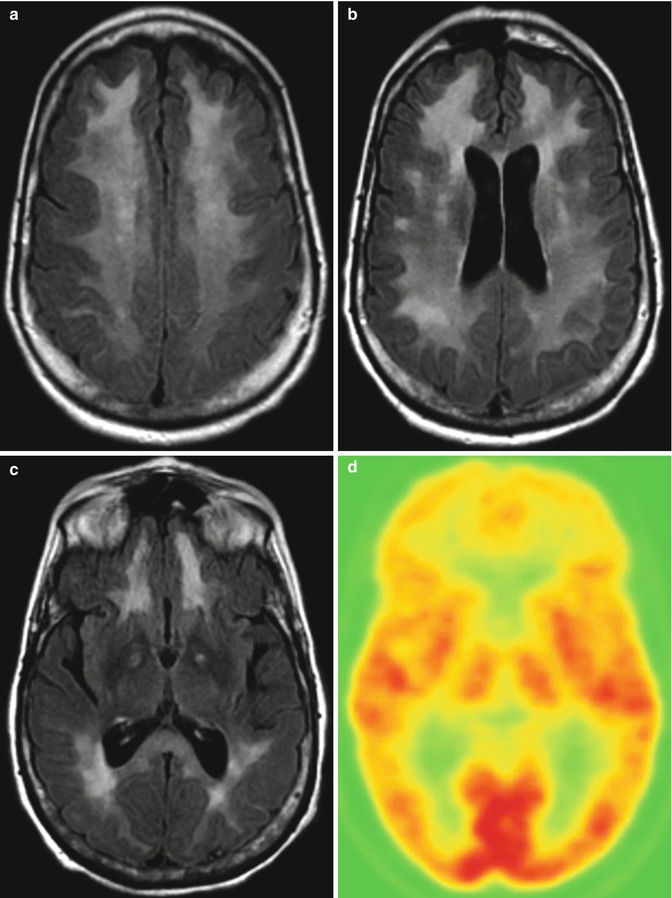

Fig. 7.4
Delayed posthypoxic leukoencephalopathy. Axial FLAIR MR images (a–c) show extensive bilateral cerebral white matter hyperintensity with corresponding global hypometabolism with relative sparing of the occipital lobes on 18FDG-PET (d)
Infections of the central nervous system are potentially devastating consequences of administering heroin and many other illicit drugs via injection. In particular, unsanitary practices such as neglecting to cleanse the skin prior to injection and using contaminated needles can introduce pathogens that cause skin infections and infective endocarditis, which can then lead to the formation of brain abscess. Staphylococcus aureus is a common organism found in intravenous drug-use-associated abscess and typically appears as a ring-enhancing lesion with restricted diffusion and surrounding edema (Fig. 7.5). Central nervous system infections can also occur in the absence of infective endocarditis, resulting from bacteremia. This can result in discitis-osteomyelitis and facet joint septic arthritis in the spine (Fig. 7.6) and septic thrombophlebitis in the neck (Fig. 7.7). Contrast-enhanced MRI is useful for evaluating these infections and associated spinal canal compromise. Antimicrobial therapy often combined with surgical intervention is necessary to treat these neurologic complications. Individuals that practice injection drug use are also at risk of acquiring HIV, which can also have neurological manifestations, including encephalitis and associated opportunistic infections, such as fungal abscesses, toxoplasmosis, and PML due to immune system compromise (refer to Chap. 26). Furthermore, certain drugs, including marijuana and opioids and cocaine, may have effects on the immune system mediated indirectly by drug interactions in the central nervous system or directly through activation of cognate receptors on various immune cells, which may predispose to infections.
